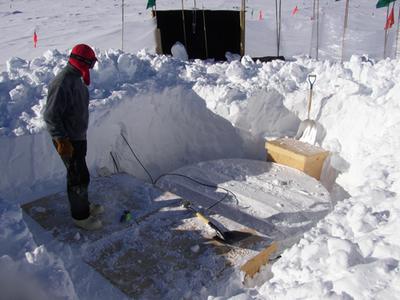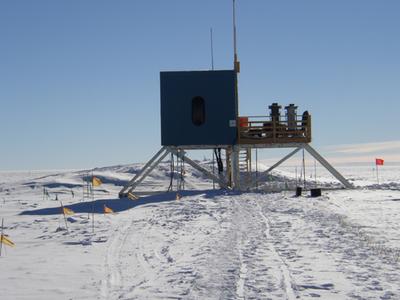
|
|
6 December, 2002
6 December, 2002
Bai & I went out to the SPASE (South Pole Air Shower Experiment)
shack and put in a full day's work. SPASE is designed to detect muons
from above, and consists of about 4 acres of 100 or so widely spaced
scintillator detectors. When a charged parcticle enters the Earth's
atmosphere, it interacts, usually with a nitrogen atom, and creates a
cascade of millions or billions of secondary parcticles. Many of these
secondaries are muons, a sort of heavy electron with a very finite
lifetime. The more energy the original parcticle had, the more
secondaries are created. You need a big detector area to image
extensive air showers, and that's what SPASE is.
That's also what WALTA (Washington Area Large-Scale Time Coincidence
Array) is. WALTA's the cosmic ray experiment I'm involved with in
collaboration with many Seattle area high schools and the University
of Washington. Our WALTA array will cover a much larger area than
SPASE but with many fewer detectors. The ultimate difference is in
the energies of the primary parcticles each can detect.
Part of SPASE is an experimental ice tank. Muons entering the dense
ice of the tank interact with water molecules and create faint
Cerenkov light. This light can be detected by PMTs (photomultiplier
tubes) which sit frozen in the top of the ice. The ICECUBE neutrino
detector will incorporate many surface tanks like this one in a
surface array called ICETOP as a way to get information about the
muons from the atmosphere entering the ICECUBE neutrino detector.
Ultimately, ICECUBE is not interested in these atmospheric muons.
Rather, they represent noise in the data, and ICETOP will provide a
sort of data filter to subtract atmospheric muons from the data.
The tank was finished last summer, and sealed up, and there's lots of
questions. To answer them, we have to dig out the tank. The South
Pole is flatter than Kansas. Anything that dares stick out above the
horizon quickly aquires drifting show. That's what all the bulldozers
are up to: just moving snow downwind of the station. The tank? Last
year, the top was at snow level. This year, a meter and a half under.
Fortunately for me, during the long holdover at McMurdo, Bai dug most
of it out. We finished the job (this snow is easy to dig, sort of
like styrofoam), and cut the tyvek covering and the black light-tight
shroud, and opened up the tank. The tank didn't freeze very clear,
and some new cracks appeared around one the PMTs. Anything less than
clear ice ultimately changes, and not for the better, the ability of
light to reach the PMT. But a crack that was present at freezing last
year had nearly disappeared. This is surprisingly dynamic process in
this tank of ice. We repaired a couple of cables, and drilled some
very narrow deep holes to install some temperature sensors (Bai is
curious about the winter temperatures of the PMTs, which are only
rated to -55 C, but of course the air gets much colder here) At the
end of drilling, Bang! A new pressure crack appeared, 30 degrees off
horizontal, not reaching the surface. Ice is weird. While we were
standing around, it gave a couple of low moans.
Note: untangling extension cords at - 30 C is not easy. The plastic
insulation makes the wire like spaghetti: dry spaghetti, that is.
We also ran some experiments with my portable detector (more on that
in a future journal)
AMANDA meeting after dinner. I was so tired. Bob Morse from the
University of Wisconsin is leaving tomorrow, and wanted to do a go
around and get tasks lined up.

Here's Bai, looking at the immense hole he & I dug to get at the ice tank (Bai, 93 %, Eric 7 %)

This is the SPASE shack. It's no bigger than a small bedroom, crammed with machines, electronics, computers, wires, and stuff. But it's warm. If you missed it and kept walking on this path, you'd have at least 700 miles of snow before you reached even a rock.

Uncovering the tank. Notice the ice: it's like glass. Not ! Bai has been working for months learning how to freeze a large tank like this and get crystal clear ice. The globe-y thing is the downward-looking photomultiplier tube, encased in a very thick acrylic pressure sphere. One of these costs about $ 7,000. That's before you get it to the pole, where we were told the food costs 16 times as much as at home. So figure out what 2 of these PMTs are worth...
Contact the TEA in the field at
.
If you cannot connect through your browser, copy the
TEA's e-mail address in the "To:" line of
your favorite e-mail package.
|
